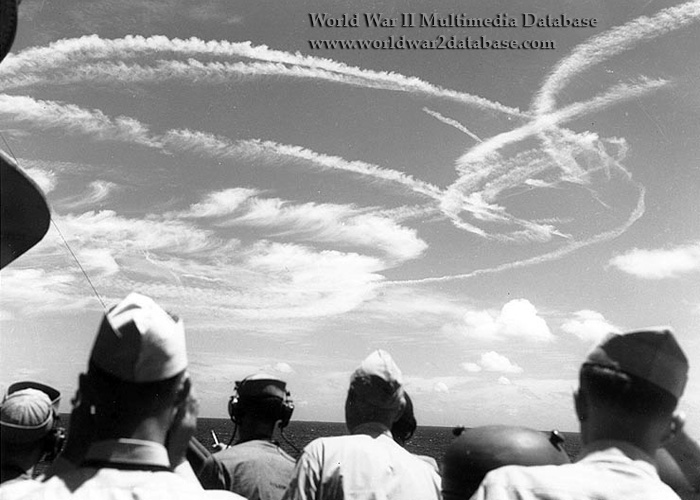| The crew of USS Birmingham (CL-62) attached to Cruiser Division 12, Task Group 58.3, watch the aerial fight for the skies during the Battle of the Philippine Sea. On June 19, 1944, an A6M Zero-Sen fighter located Task Force 58 before he was shot down. In response to the invasion of Saipan on June 15, five waves of attacking Japanese aircraft came at the United States Navy from bases in the Marianas and the remaining carriers of the Imperial Japanese Navy under Vice Admiral Jisaburo Ozawa. United States Navy submarines attacked his ships as they approached the Marianas. USS Albacore (SS-218) hit Taiho with one torpedo and faulty damage control caused an explosion that sank her. The first wave, 50 aircraft from Orote Airfield on Guam, were spotted on radar as they took off at around 0900 Hours. Grumman F6F Hellcats broke up their launch, and 35 Japanese aircraft were shot down. The first Japanese carrier-borne attack came at 1000; detected 150 miles (280 kilometers) out, 41 Japanese aircraft were destroyed for the loss of one American. At 1049, a D4Y “Judy“ dropped a 500 pound (250 kg) bomb on USS South Dakota‘s (BB-57) main deck where it blew a large hole, cut wiring and piping, and killed twenty-four and wounded 27. At 1107, 109 Japanese carrier aircraft advanced on Fifth Fleet in the largest attack of the day; met at 60 miles (110 kilometers) out by the American fighters, 97 were shot down. Ozawa‘s third wave launched by 1130. Disorganized because of a navigation failure, blundered in small groups into Fifth Fleet; 30 of 49 Japanese aircraft were destroyed. The last Japanese attack came at 1300. Intercepted 50 miles (90 kilometers) from Task Force 58, most turned for bases in the Marianas; 7 out of 47 aircraft were shot down. While the Japanese carriers launched, USS Cavalla (SS-244) hit Shokaku with four torpedoes, causing bombs on the planes waiting for takeoff to explode. She sank quickly with 1,263 officers and men. 570 survivors, including the carrier‘s commander, Captain Matsubara Hiroshi, were rescued by destroyers. The Americans found the Japanese Fleet at 1540 and launched 216 planes, which attacked at 1830, only minutes before dark. Task Force 58 aircraft sank two oilers, the carrier Hiyo, and damaged Zuikaku, Junyo, and Chiyoda. Most of Hiyo‘s crew survived. Some 400 Japanese carrier planes and 200 land based planes were lost during the battle. Only 35 carrier aircraft were available on June 20. Japanese mobile air power ceased to exist after the Marianas campaign; the ships themselves were used as decoys in October 1944 during the Battle of Leyte Gulf. | |
| Image Filename | wwii1278.jpg |
| Image Size | 147.71 KB |
| Image Dimensions | 700 x 500 |
| Photographer | Unknown |
| Photographer Title | |
| Caption Author | Jason McDonald |
| Date Photographed | June 19, 1944 |
| Location | USS Birmingham (CL-62) |
| City | USS Birmingham (CL-62) |
| State or Province | Battle of the Philippine Sea |
| Country | Marianas |
| Archive | United States Naval Historical Center |
| Record Number | |
| Status | Caption ©2007, ©2024 MFA Productions LLC Image in the Public Domain |

Author of the World War II Multimedia Database

